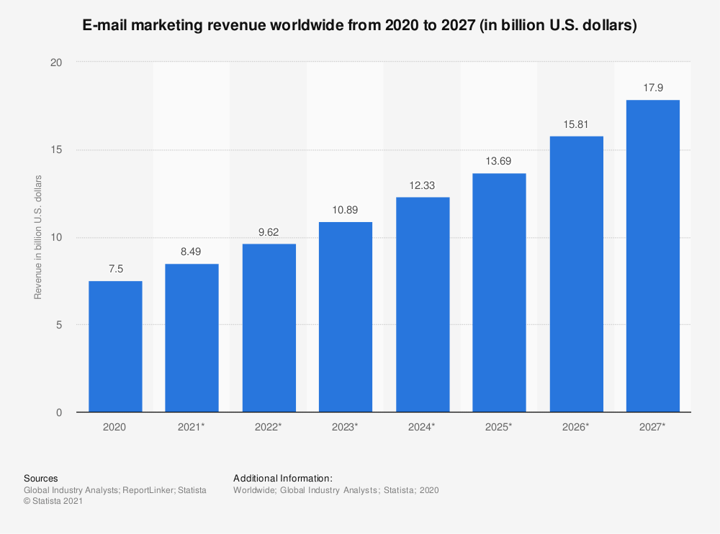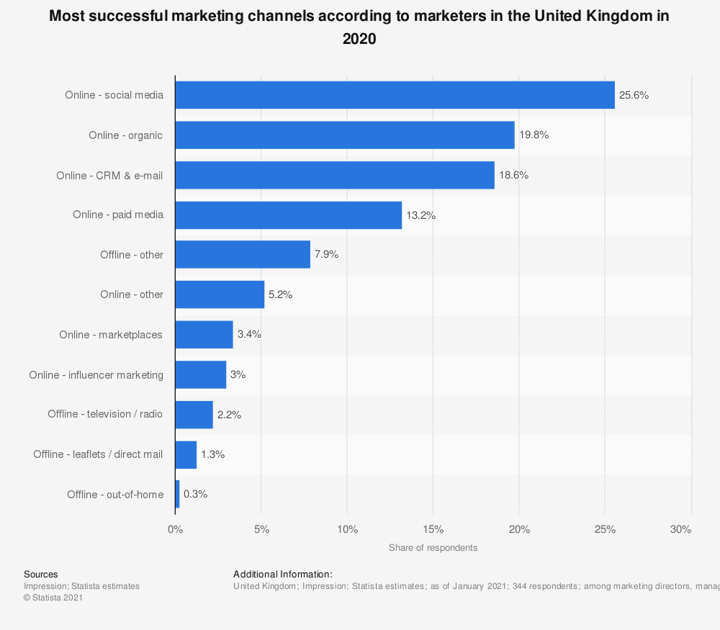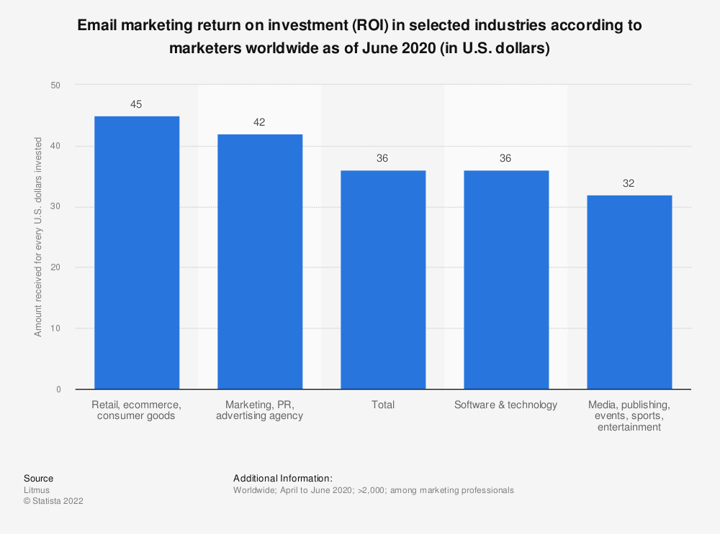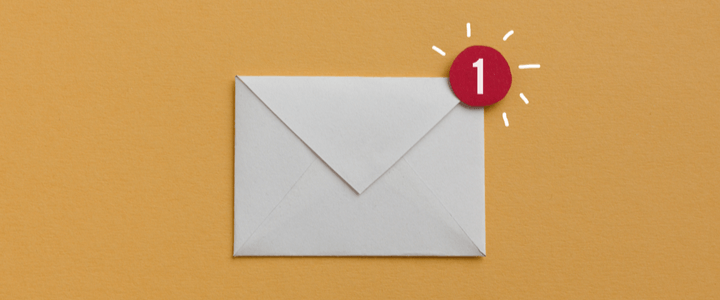SEO Tips for E-commerce: Improve Your Online Shop's Ranking in Google
SEO is an important tool for e-commerce businesses to bring in new customers. Here are the best tips for your online shop to rank higher in Google.

Email marketing and newsletters have been around nearly as long as the internet itself. Because of that, emails can sometimes seem like an old-fashioned marketing strategy. In actuality, this couldn’t be further from the truth. Email marketing is still a very profitable marketing tactic! Today, we'll share 9 tips for a successful email marketing campaign!
Sending out email newsletters to your subscribers can bring many benefits to your business.
For starters, newsletters allow you to address your customers personally (more on this later). Not even social media can do it to the degree that email marketing can. Being able to address them personally with relevant information can increase open rates, the chances of purchases and perhaps even more importantly, customer loyalty.
Speaking of relevant information, you can send out promotions directly to them. Whether it’s a Black Friday sale, a Valentine’s Day offer, or a discount for Mother’s Day, you can inform your customers of upcoming events in a timely manner.
Another huge advantage of sending out newsletters is that they are incredibly cost effective. Having a good email marketing system tends to be quite affordable, especially compared to other marketing efforts.
If the points above don’t prove the point well enough, some statistics on email marketing should convince you.
In the chart below, you can see that email marketing revenue is estimated to continue increasing, reaching a total of $17.9 billion by 2027.

Source: Statista
If we look to the UK specifically, we can see that email marketing is in the top 3 for successful marketing channels.

Source: Statista
How’s that for old-fashioned?
Here's one more chart to look at. According to a world-wide survey, for every dollar spent on email marketing, companies received 36 dollars back in business. Clearly, email marketing has a great return-on-investment (ROI).

Source: Statista
Now that the benefits of newsletters and email marketing are clear, let’s have a look at some of the most important things to keep in mind when creating a newsletter campaign.
There are a lot of things to keep in mind if you want to run a successful newsletter or email marketing campaign. It all begins with your recipients:
If you want to create a professional newsletter, the first thing you need to do is get an audience! Remember, you need to gather this list in the right way (otherwise, you risk paying some hefty fines). The GDPR regulations set forth by the EU in 2019 are there to make sure websites acquire and use data like this responsibly (and legally)!
With that in mind, take the opportunity to promote your newsletter wherever you can:
You might even want to consider incentivising users to sign up by giving them a one-time discount on their next purchase if they sign up. Just make sure to be clear about what your offer is and what benefit it brings them to sign up for it (more on this later).
Segmenting your newsletter recipients might make sense for you to do at different stages throughout your business’s development. However, it’s an important thing to keep in mind now while you’re getting started as well.
Segmenting your newsletters might be a logical strategy, especially if your shop has a variety of customer personas. If your target audience is varied, then it makes sense that you’d want to send them different offers and different content. The obvious example would be to segment by gender. If you’re a fashion brand, you wouldn’t necessarily want to promote your sale on women’s clothing to your male customers, would you?

Segmenting your audience can lead to better open rates
(Image source: Shutterstock/Andrii Yalanskyi)
If you have really loyal customers, you might want to create a special newsletter for your VIPs (e.g. early access to new products).
By making your newsletter more relevant to the reader, you will definitely increase the odds of them opening your emails, thus making your marketing efforts really valuable!
You’ve got your list set up. You’ve segmented your audience. It might sound silly, but it needs to be said: offer value to your recipients!
If you’re strictly offering discounts, this shouldn’t be too much of a problem. However, this may not get you consistent open rates. That’s not to say that offering discounts and promoting sales is a no-go (seasonal emails can be a great way to get traffic to your site). It just might not build much of a relationship with your audience in the long-term.
If you’re going to take it an extra step, you can offer them content. If you run a blog to build your site’s search engine ranking, this content is perfect for adding to your newsletters (as long as they are useful and relevant to your audience).
If you’re a fashion brand, you can offer styling tips. If you sell electronics, maybe you have a product review blog or video. This strategy works particularly well for niche markets. Whatever the case may be, give them a reason to open your emails consistently.
Providing great content and real value for your audience is clearly important. However, getting your audience to open those newsletters in the first place can really be a challenge. If you’re in sales, this shouldn’t be much of a shock to you.
There's an expression in sales: You don’t sell the steak; you sell the sizzle.

Shutterstock/Marie Maerz
In this metaphor, think of your subject line as the “sizzle”. That doesn’t mean you should be inauthentic or disingenuous, but try to catch their attention with a good subject line. What is the best content offer you’ve got in this newsletter? Highlight it in the subject line! Offering a big discount? Make sure it’s in the subject line!
It’s worth noting the technical side of things as well. Make sure your subject lines are no longer than 75 characters (including spaces). Some mobile devices go even lower (iPhones can be as low as 41 characters in portrait mode), so be economical with your texts and make sure the eye-catching points are at the beginning of the subject line.
Subject lines are super important, but you can also inspire clicks with a good pre-header. Most inboxes will display the first few lines of an email as a preview to the reader. Make sure these lines can inspire as well!
Create urgency by reminding them that your offer is for a limited time. Highlight something new like free shipping. Whatever the benefit of this particular email is should be clear within the subject line or pre-header.
The design of your newsletter should have one main goal: get the user to go wherever it is that you want them to go. Most likely, this will be your website.
Some of your readers will want to get to the point right away. For them, make sure you put the link or call-to-action (CTA) button towards the top.
Other users may want a bit more information before the commit to the click. For those users, you should give them a taste of what they should come to expect and then place a second CTA at the bottom of the newsletter.
Your email marketing platform most likely has an option for you to greet your recipients by their first name (provided you have this information in the system and have obtained it legally). Add this into the subject line and you increase the odds that they’ll open the email.
Recommended reading:
Personalisation in E‑commerce: Customising the Customer Journey

Shutterstock/StockEU
One thing to consider is the text-to-image ratio. Many experts agree on the 60-40 rule, meaning your email should consist of at least 60% text. Although texts might come across as visually appealing, some platforms like Outlook don't download images by default.
If you use images to communicate some of your texts, then those messages might get lost if the images don't load. Having texts inside images also means users can't search for your emails at a later point easily since the texts can't be read by your email platform.
Recommended reading:
Trust Marketing: Building Confidence With Your Target Audience
Make sure your emails can be read in dark mode. Not everyone likes reading their emails with a white background, especially those night owls who read emails from their bed at night.
Speaking of reading email in bed, make sure your emails are mobile responsive. In other words, make sure the design of your emails look good on mobile phones. These days, most emails are actually read on mobile devices. Many professional newsletter tools therefore offer a series of ready-made responsive templates, which you only have to adapt with your content.
You should definitely consider the time that you send out your newsletter. This refers to the time of day, day of the week, and even the time of the month.
Generally speaking, as a B2C company, you will probably want to send out your promotional emails towards the beginning of the month when your users have gotten their salaries (depending on their market - many European countries receive their salaries monthly, while others receive them bi-monthly). Also, keep holidays in mind.

Shutterstock/Chutima Chaochaiya
If you’re not sure about the time-of-day, or day of the week, you should consider running some A/B tests...
A/B testing is one of the most important strategies in marketing. If you’re unfamiliar with the concept, A/B testing refers to testing different elements of what your audience sees and analysing which version produced better results.
In the context of email marketing, you might test one or two versions of a subject line against each other to see which one leads to more clicks. In this example, one subject line might be very informative while the other one might be a bit more click-baity.
Although you might think you know what your audience will react to, it’s always worth running A/B tests because you’ll be surprised more often you think. There are so many elements that you can test. However, it’s generally a good idea to test one thing at a time so you can pinpoint what element is having a greater impact.
As mentioned in the previous section, you can also test different times and days of the week for sending out your newsletters to see what times lead to better open rates.
Analysing your results is important for A/B tests, but for other parts of your business as well. This includes the analysis of your newsletters and email marketing campaigns.
Make sure to check how your newsletters perform, whether it’s the time of day, the segmented lists, the types of subject lines you use. Make sure you see what links are being clicked. This can influence what you highlight in your subject line or even the order of the content that you place in your newsletters.
Most importantly, try to learn from your analysis and make improvements along the way.
As mentioned before, it’s getting more and more important to be legally compliant in the digital world these days. The Wild West days of the internet are slowly evolving into a world with more rules and regulations, particularly in Europe.
Make sure you’ve acquired email addresses legally. Make sure you store customer data responsibly. Make sure you always include an “unsubscribe” button at the bottom of your newsletters and promotional emails. Besides being legally compliant, it's actually preferred that a user unsubscribes rather than marking your emails as spam. Spam clicks can affect the deliverability of your emails to other recipients.
Email recipients should also go through the “double opt-in” workflow to confirm they’ve chosen to be added to your email list when first signing up.
Recommended reading:
The Art of Sending Email Newsletters Lawfully
Newsletters and email marketing campaigns can be very fruitful for your business if done correctly. With proper planning, they can give your sales a nice boost while also building up customer loyalty for a relatively low cost.
Portions of this article were contributed by guest author Kevin Grimberg.
14/07/22SEO is an important tool for e-commerce businesses to bring in new customers. Here are the best tips for your online shop to rank higher in Google.
Valentine's Day has grown in popularity across Europe. We're sharing some romantic statistics (redundant, right?) and look at 9 marketing tips for V-day.